Evolution and Multi-Scenario Prediction of Land Use and Carbon Storage in Jiangxi Province
Abstract
:1. Introduction
2. Study Area and Data
2.1. Study Area
2.2. Data Source
3. Research Methods
3.1. Transfer Matrix of Land Use
3.2. InVEST Model
3.3. PLUS Model
3.4. Simulation Scenario Setting
4. Results and Analysis
4.1. Land Use Change from 2000 to 2020
4.1.1. Spatial Distribution and Changes in Land Use
4.1.2. Land Use Transfer Analysis
4.2. Carbon Storage Change from 2000 to 2020
4.3. Scenario Simulation in 2040
4.3.1. Analysis of Driving Factors of Land Use Expansion
4.3.2. Land Use Scenario Simulation in 2040
4.3.3. Carbon Storage Scenarios Simulation in 2040
5. Discussion
5.1. Analysis of Changes in Land Use and Carbon Storage
5.2. Carbon Storage Development Strategy of Jiangxi Province
5.3. Uncertainty and Limitation
6. Conclusions
- (1)
- Land use in Jiangxi Province underwent significant changes in 2000–2020, which mainly occurred during 2010–2020. During 2000–2020, the area of cropland, forest, grassland, and unused land has declined, whereas the area of waters and built-up land has increased. Among the changes, the most significant decrease was observed in cropland, while the built-up land area experienced the most substantial increase. And there has been a large-scale conversion of cropland and forest.
- (2)
- Land-use change resulted in a 2882.99 × 104 t reduction in carbon storage, with a decrease of 92.01% occurring from 2010 to 2020. Forests made the most significant contribution to the carbon storage of Jiangxi Province. By prioritizing the protection and management of forest resources, Jiangxi Province can play a significant role in mitigating climate change and ensuring a sustainable future.
- (3)
- By 2040, under S1, areas of cropland, forest, and grassland are projected to decrease, while the area of cropland and forest will increase in S2 and S3, respectively, and the area of both cropland and forest will increase in S4. Moreover, the area of built-up land will keep growing except for S4, and the expansion area will be the largest under S1.
- (4)
- By 2040, the carbon storage under S1, S2, S3, and S4 are projected to be 119,681.36 × 104 t, 118,820.39 × 104 t, 122,406.33 × 104 t, and 122,531.04 × 104 t, respectively. S4 is expected to yield the largest carbon storage while S2 is anticipated to result in the lowest. It is important to note that simply protecting cropland will not significantly increase carbon storage. To ensure efficient carbon storage in the future, it is crucial to maintain both cropland and ecological health.
Author Contributions
Funding
Data Availability Statement
Acknowledgments
Conflicts of Interest
References
- Piao, S.; Fang, J.; Ciais, P.; Peylin, P.; Huang, Y.; Sitch, S.; Wang, T. The carbon balance of terrestrial ecosystems in China. Nature 2009, 458, 1009–1013. [Google Scholar] [CrossRef] [PubMed]
- Zhang, S.; Yang, P.; Xia, J.; Wang, W.; Cai, W.; Chen, N.; Hu, S.; Luo, X.; Li, J.; Zhan, C. Land use/land cover prediction and analysis of the middle reaches of the Yangtze River under different scenarios. Sci. Total Environ. 2022, 833, 155238. [Google Scholar] [CrossRef] [PubMed]
- Hu, Q.; Li, T.; Deng, X.; Wu, T.; Zhai, P.; Huang, D.; Fan, X.; Zhu, Y.; Lin, Y.; Xiao, X.; et al. Intercomparison of global terrestrial carbon fluxes estimated by MODIS and Earth system models. Sci. Total Environ. 2022, 810, 152231. [Google Scholar] [CrossRef] [PubMed]
- Mulat, Y.; Kibret, K.; Bedadi, B.; Mohammed, M. Soil organic carbon stock under different land use types in Kersa Sub Watershed, Eastern Ethiopia. Afr. J. Agric. Res. 2018, 13, 1248–1256. [Google Scholar]
- Solomon, N.; Pabi, O.; Annang, T.; Asante, I.K.; Birhane, E. The effects of land cover change on carbon stock dynamics in a dry Afromontane forest in northern Ethiopia. Carbon Balance Manag. 2018, 13, 14. [Google Scholar] [CrossRef]
- Sun, F.; Fang, F.; Hong, W.; Luo, H.; Yu, J.; Fang, L.; Miao, Y. Analysis and prediction of carbon stock evolution in Anhui Province based on PLUS and InVEST models. Res. Soil Water Conserv. 2023, 37, 151–158. (In Chinese) [Google Scholar]
- Liang, Y.; Hashimoto, S.; Liu, L. Integrated assessment of land-use/land-cover dynamics on carbon storage services in the Loess Plateau of China from 1995 to 2050. Ecol. Indic. 2021, 120, 106939. [Google Scholar] [CrossRef]
- Li, Y.; Yang, X.; Wu, B.; Zhao, J.; Jiang, W.; Feng, X.; Li, Y. Spatio-temporal evolution and prediction of carbon storage in Kunming based on PLUS and InVEST models. PeerJ 2023, 11, e15285. [Google Scholar] [CrossRef]
- Gupta, S.; Nainwal, A.; Anand, S.; Singh, S. Valuation of carbon sequestration in bidhalnamicrowatershed, uttarakhand, India using invest model. Int. J. Adv. Earth Environ. Sci. 2017, 5, 10–15. [Google Scholar]
- Chang, X.; Xing, Y.; Wang, J.; Yang, H.; Gong, W. Effects of land use and cover change (LUCC) on terrestrial carbon stocks in China between 2000 and 2018. Resour. Conserv. Recycl. 2022, 182, 106333. [Google Scholar] [CrossRef]
- Homer, C.; Dewitz, J.; Jin, S.; Xian, G.; Costello, C.; Danielson, P.; Gass, L.; Funk, M.; Wickham, J.; Stehman, S.; et al. Conterminous United States land cover change patterns 2001–2016 from the 2016 national land cover database. ISPRS J. Photogramm. Remote Sens. 2020, 162, 184–199. [Google Scholar] [CrossRef]
- Zhu, E.; Deng, J.; Zhou, M.; Gan, M.; Jiang, R.; Wang, K.; Shahtahmassebi, A. Carbon emissions induced by land-use and land-cover change from 1970 to 2010 in Zhejiang, China. Sci. Total Environ. 2019, 646, 930–939. [Google Scholar] [CrossRef]
- Li, J.; Guo, X.; Chuai, X.; Xie, F.; Yang, F.; Gao, R.; Ji, X. Reexamine China’s terrestrial ecosystem carbon balance under land use-type and climate change. Land Use Policy 2021, 102, 105275. [Google Scholar] [CrossRef]
- Wang, Z.; Zeng, J.; Chen, W. Impact of urban expansion on carbon storage under multi-scenario simulations in Wuhan, China. Environ. Sci. Pollut. Res. 2022, 29, 45507–45526. [Google Scholar] [CrossRef] [PubMed]
- Muñoz-Rojas, M.; Jordán, A.; Zavala, L.M.; De la Rosa, D.; Abd-Elmabod, S.K.; Anaya-Romero, M. Impact of land use and land cover changes on organic carbon stocks in Mediterranean soils (1956–2007). Land Degrad. Dev. 2015, 26, 168–179. [Google Scholar] [CrossRef]
- Li, J.; Wang, Z.; Lai, C.; Wu, X.; Zeng, Z.; Chen, X.; Lian, Y. Response of net primary production to land use and land cover change in mainland China since the late 1980s. Sci. Total Environ. 2018, 639, 237–247. [Google Scholar] [CrossRef] [PubMed]
- Zhu, L.; Song, R.; Sun, S.; Li, Y.; Hu, K. Land use/land cover change and its impact on ecosystem carbon storage in coastal areas of China from 1980 to 2050. Ecol. Indic. 2022, 142, 109178. [Google Scholar] [CrossRef]
- Chen, D.; Zhou, X.; Yang, S.; Pei, Y.; Hu, Y.; Hu, F. Analysis of carbon stock and its vulnerability characteristics based on land change in Guizhou Province. Bull. Soil Water Conserv. 2023, 43, 301–309. (In Chinese) [Google Scholar]
- Kondo, M.; Ichii, K.; Patra, P.K.; Canadell, J.G.; Poulter, B.; Sitch, S.; Calle, L.; Liu, Y.Y.; Dijk, A.I.J.M.; Saeki, T.; et al. Land use change and El Niño-Southern Oscillation drive decadal carbon balance shifts in Southeast Asia. Nat. Commun. 2018, 9, 1154. [Google Scholar] [CrossRef]
- Mansour, S.; Al-Belushi, M.; Al-Awadhi, T. Monitoring land use and land cover changes in the mountainous cities of Oman using GIS and CA-Markov modelling techniques. Land Use Policy 2020, 91, 104414. [Google Scholar] [CrossRef]
- Fu, F.; Deng, S.; Wu, D.; Liu, W.; Bai, Z. Research on the spatiotemporal evolution of land use landscape pattern in a county area based on CA-Markov model. Sustain. Cities Soc. 2022, 80, 103760. [Google Scholar] [CrossRef]
- Yang, X.; Chen, R.; Zheng, X.Q. Simulating land use change by integrating ANN-CA model and landscape pattern indices. Geomat. Nat. Hazards Risk 2016, 7, 918–932. [Google Scholar] [CrossRef]
- Xu, Q.; Wang, Q.; Liu, J.; Liang, H. Simulation of land-use changes using the partitioned ANN-CA model and considering the influence of land-use change frequency. ISPRS Int. J. Geoinf. 2021, 10, 346. [Google Scholar] [CrossRef]
- Liao, G.; He, P.; Gao, X.; Lin, Z.; Huang, C.; Zhou, W.; Deng, O.; Xu, C.; Deng, L. Land use optimization of rural production–living–ecological space at different scales based on the BP–ANN and CLUE–S models. Ecol. Indic. 2022, 137, 108710. [Google Scholar] [CrossRef]
- Mamanis, G.; Vrahnakis, M.; Chouvardas, D.; Nasiakou, S.; Kleftoyanni, V. Land use demands for the CLUE-S spatiotemporal model in an agroforestry perspective. Land 2021, 10, 1097. [Google Scholar] [CrossRef]
- Liu, P.; Hu, Y.; Jia, W. Land use optimization research based on FLUS model and ecosystem services–setting Jinan City as an example. Urban Clim. 2021, 40, 100984. [Google Scholar] [CrossRef]
- Lin, W.; Sun, Y.; Nijhuis, S.; Wang, Z. Scenario-based flood risk assessment for urbanizing deltas using future land-use simulation (FLUS): Guangzhou Metropolitan Area as a case study. Sci. Total Environ. 2020, 739, 139899. [Google Scholar] [CrossRef]
- Wang, Z.; Li, X.; Mao, Y.; Li, L.; Wang, X.; Lin, Q. Dynamic simulation of land use change and assessment of carbon storage based on climate change scenarios at the city level: A case study of Bortala, China. Ecol. Indic. 2022, 134, 108499. [Google Scholar] [CrossRef]
- Liang, X.; Guan, Q.; Clarke, K.C.; Liu, S.; Wang, B.; Yao, Y. Understanding the drivers of sustainable land expansion using a patch-generating land use simulation (PLUS) model: A case study in Wuhan, China. Comput. Environ. Urban Syst. 2021, 85, 101569. [Google Scholar] [CrossRef]
- Tian, L.; Tao, Y.; Fu, W.; Li, T.; Ren, F.; Li, M. Dynamic simulation of land use/cover change and assessment of forest ecosystem carbon storage under climate change scenarios in Guangdong Province, China. Remote Sens. 2022, 14, 2330. [Google Scholar] [CrossRef]
- Wang, R.Y.; Cai, H.; Chen, L.; Li, T. Spatiotemporal Evolution and Multi-Scenario Prediction of Carbon Storage in the GBA Based on PLUS–InVEST Models. Sustainability 2023, 15, 8421. [Google Scholar] [CrossRef]
- Meimei, W.; Zizhen, J.; Tengbiao, L.; Yongchun, Y.; Zhuo, J. Analysis on absolute conflict and relative conflict of land use in Xining metropolitan area under different scenarios in 2030 by PLUS and PFCI. Cities 2023, 137, 104314. [Google Scholar] [CrossRef]
- Guo, W.; Teng, Y.; Yan, Y.; Zhao, C.; Zhang, W.; Ji, X. Simulation of Land Use and Carbon Storage Evolution in Multi-Scenario: A Case Study in Beijing-Tianjin-Hebei Urban Agglomeration, China. Sustainability 2022, 14, 13436. [Google Scholar] [CrossRef]
- Huang, H.; Zhou, Y.; Qian, M.; Zeng, Z. Land use transition and driving forces in Chinese Loess Plateau: A case study from Pu County, Shanxi Province. Land 2021, 10, 67. [Google Scholar] [CrossRef]
- Yao, Z.; Wang, B.; Huang, J.; Zhang, Y.; Yang, J.; Deng, R.; Yang, Q. Analysis of land use changes and driving forces in the Yanhe River Basin from 1980 to 2015. J. Sens. 2021, 2021, 6692333. [Google Scholar] [CrossRef]
- Li, J.; Wang, J.; Li, L.; Zhou, C.; Niu, Q.; Zhang, C. Impact of land use change on carbon storage in the Dongting Lake eco-economic Zone. Chin. J. Ecol. 2022, 41, 1156–1165. (In Chinese) [Google Scholar]
- Wang, L.; Zhu, R.; Yin, Z.; Chen, Z.; Fang, C.; Lu, R.; Zhou, J.; Feng, Y. Impacts of land-use change on the spatio-temporal patterns of terrestrial ecosystem carbon storage in the Gansu Province, Northwest China. Remote Sens. 2022, 14, 3164. [Google Scholar] [CrossRef]
- Zheng, H.; Xiao, X.; Cheng, X.; Zhao, D.; Xu, J.; Fu, C.; Long, Y.; Shao, Y.; He, Y. Study on the Spatio-Temporal Dynamics of Carbon Storage in Poyang Lake Basin Based on PLUS and InVEST Models; Chinese Water Resources Pl Society: Beijing, China, 2020. (In Chinese) [Google Scholar]
- He, N.; Guo, W.; Wang, H.; Yu, L.; Cheng, S.; Huang, L.; Jiao, X.; Chen, W.; Zhou, H. Temporal and Spatial Variations in Landscape Habitat Quality under Multiple Land-Use/Land-Cover Scenarios Based on the PLUS-InVEST Model in the Yangtze River Basin, China. Land 2023, 12, 1338. [Google Scholar] [CrossRef]
- Gao, L.; Tao, F.; Liu, R.; Wang, Z.; Leng, H.; Zhou, T. Multi-scenario simulation and ecological risk analysis of land use based on the PLUS model: A case study of Nanjing. Sustain. Cities Soc. 2022, 85, 104055. [Google Scholar] [CrossRef]
- Yu, Z.; Zhao, M.; Gao, Y.; Wang, T.; Zhao, Z.; Wang, S. Land use simulation and multi- scenario prediction based on CLUE-S and PLUS models in Huaibei City. JARE, 2023; accepted. [Google Scholar]
- Ding, Y.; Wang, L.Z.; Gui, F.; Zhao, S.; Zhu, W.Y. Ecosystem Carbon Storage in Hangzhou Bay Area Based on InVEST and PLUS Models. Environ. Sci. 2023, 44, 3343–3352. (In Chinese) [Google Scholar]
- Feng, Y.; Chen, S.; Tong, X.; Lei, Z.; Gao, C.; Wang, J. Modeling changes in China’s 2000–2030 carbon stock caused by land use change. J. Clean. Prod. 2020, 252, 119659. [Google Scholar] [CrossRef]
- Li, Y.; Yao, S.; Jiang, H.; Wang, H.; Ran, Q.; Gao, X.; Ding, X.; Ge, D. Spatial-Temporal Evolution and Prediction of Carbon Storage: An Integrated Framework Based on the MOP–PLUS–InVEST Model and an Applied Case Study in Hangzhou, East China. Land 2022, 11, 2213. [Google Scholar] [CrossRef]
- Ding, J.; Chen, L.; Ji, C.; Hugelius, G.; Li, Y.; Liu, L.; Qin, S.; Zhang, B.; Yang, G.; Li, F.; et al. Decadal soil carbon accumulation across Tibetan permafrost regions. Nat. Geosci. 2017, 10, 420–424. [Google Scholar] [CrossRef]
- Yu, Z.; Lu, C.; Cao, P.; Tian, H. Long-term terrestrial carbon dynamics in the Midwestern United States during 1850–2015: Roles of land use and cover change and agricultural management. Global Chang. Biol. 2018, 24, 2673–2690. [Google Scholar] [CrossRef]
- Sha, Z.; Bai, Y.; Li, R.; Lan, H.; Zhang, X.; Li, J.; Liu, X.; Chang, S.; Xie, Y. The global carbon sink potential of terrestrial vegetation can be increased substantially by optimal land management. Commun. Earth Environ 2022, 3, 8. [Google Scholar] [CrossRef]
- Xie, F.; Zhu, S.; Cao, M.; Kang, X.; Du, J. Does rural labor outward migration reduce household forest investment? The experience of Jiangxi, China. For. Policy Econ. 2019, 101, 62–69. [Google Scholar] [CrossRef]
- Xie, F.; Kang, X.; Du, J.; Liu, X.; Zhu, S. Labor off-farm employment and household forest management investment in Jiangxi, China: A perspective from gender influence of rural labor. Nat. Resour. Model 2020, 33, e12246. [Google Scholar] [CrossRef]
- Zinda, J.A.; Zhang, Z. Stabilizing Forests and Communities: Accommodative Buffering within China’s Collective Forest Tenure Reform. China Q. 2018, 235, 828–848. [Google Scholar] [CrossRef]
- Yang, Y.; Li, H.; Liu, Z.; Hatab, A.A.; Ha, J. Effect of forestland tenure security on rural household forest management and protection in southern China. Glob. Ecol. Conserv. 2020, 22, e00952. [Google Scholar] [CrossRef]

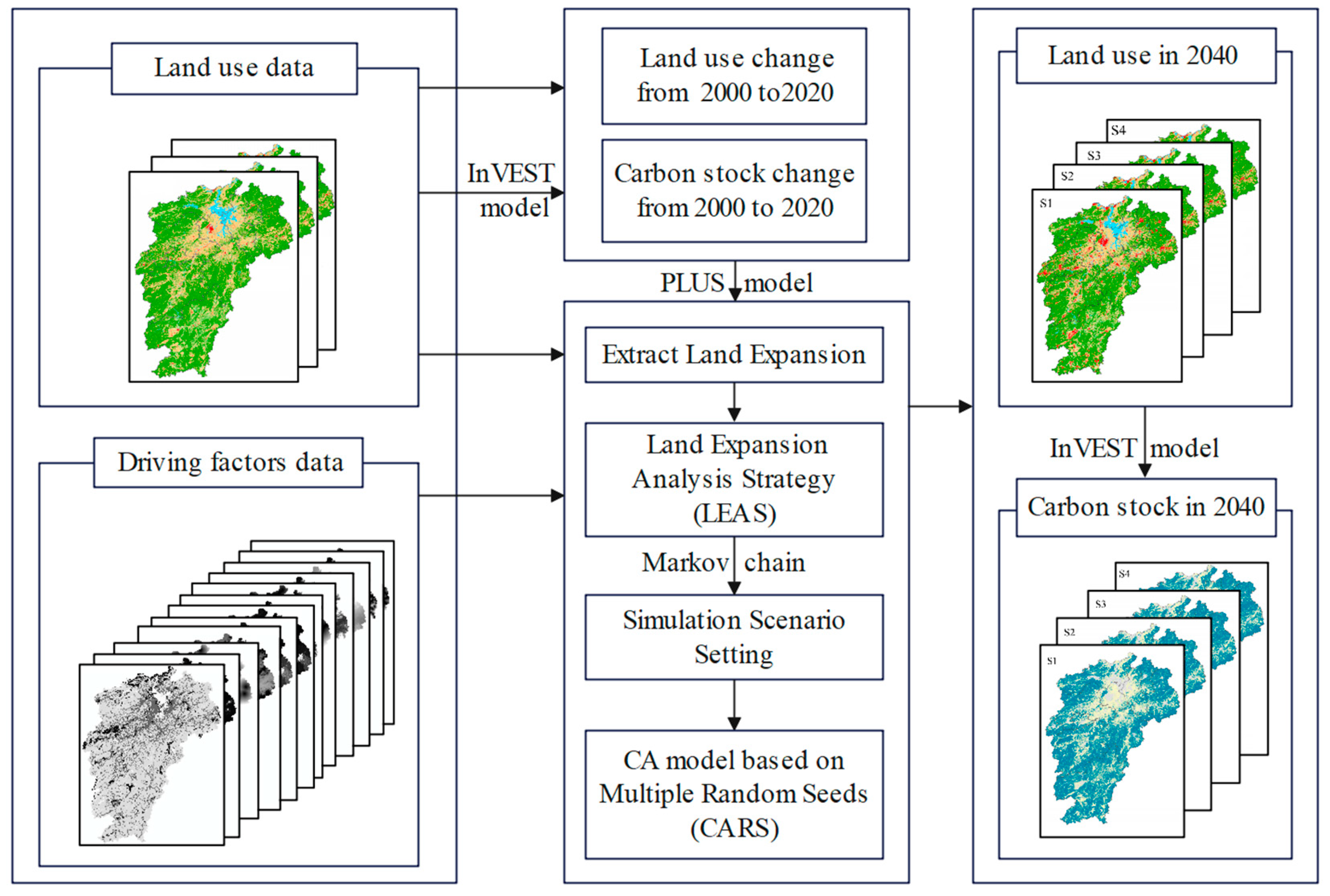


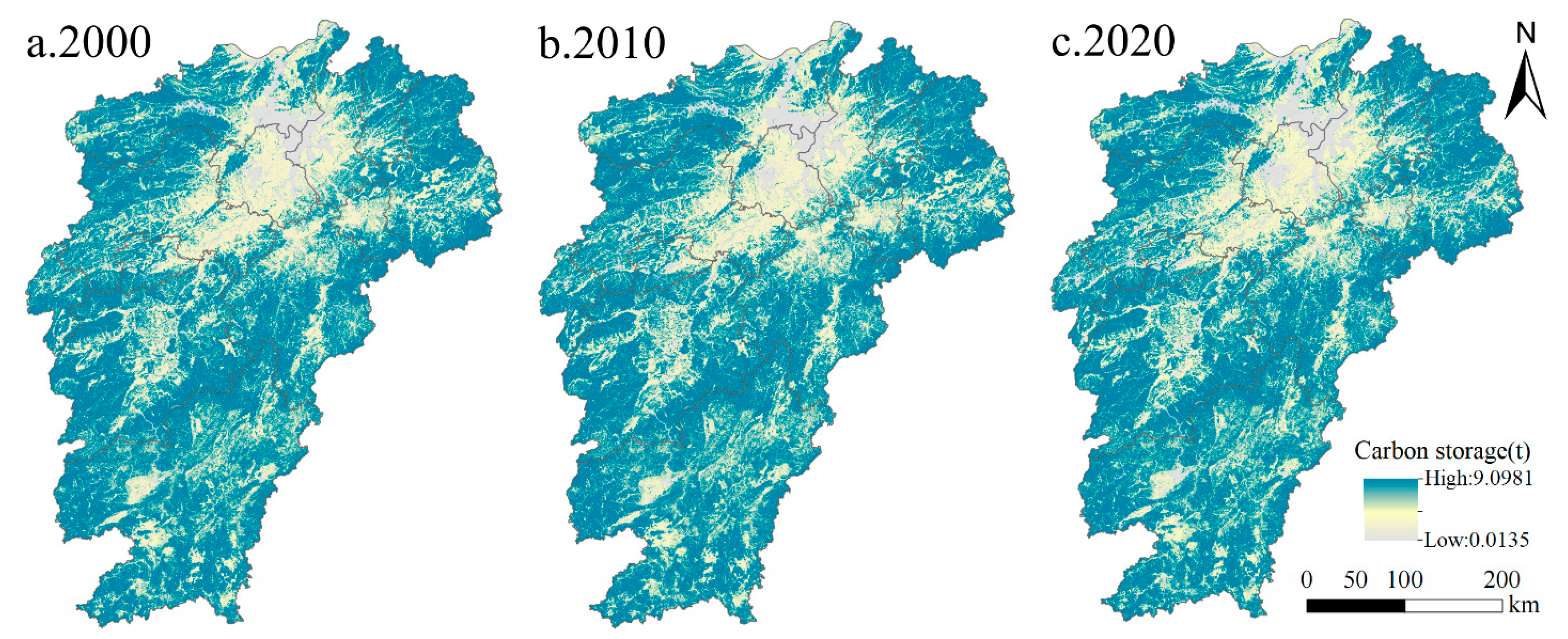
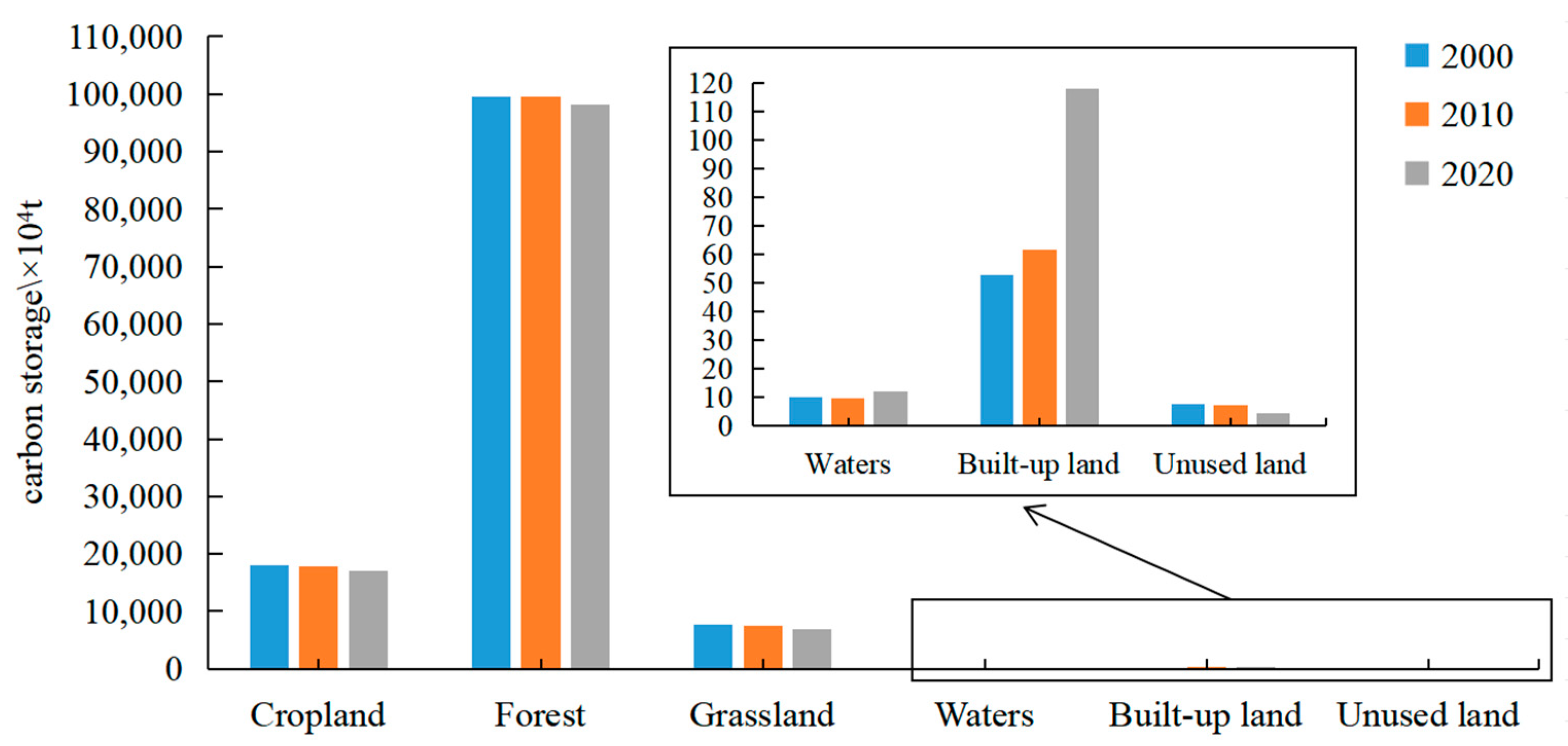

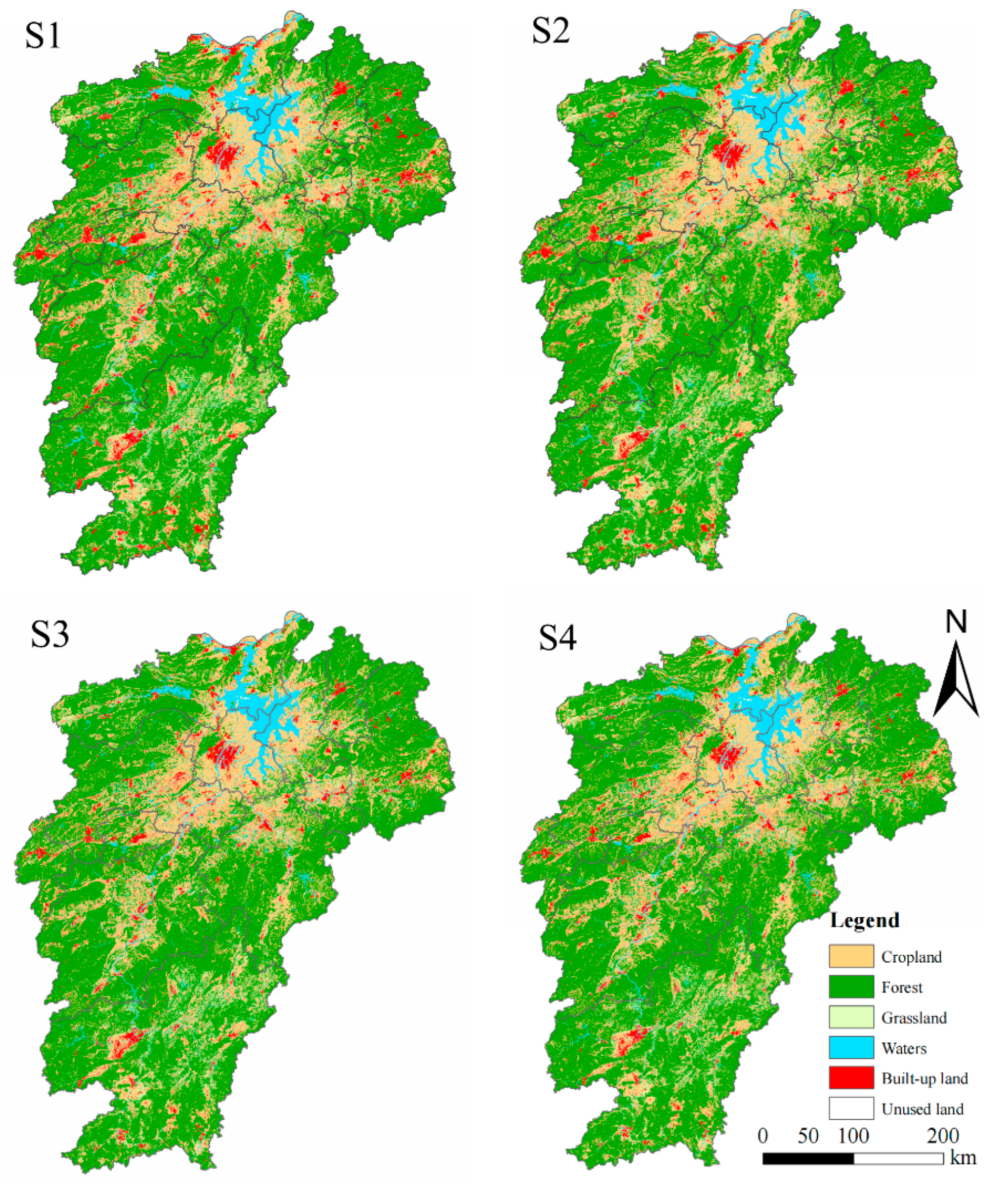
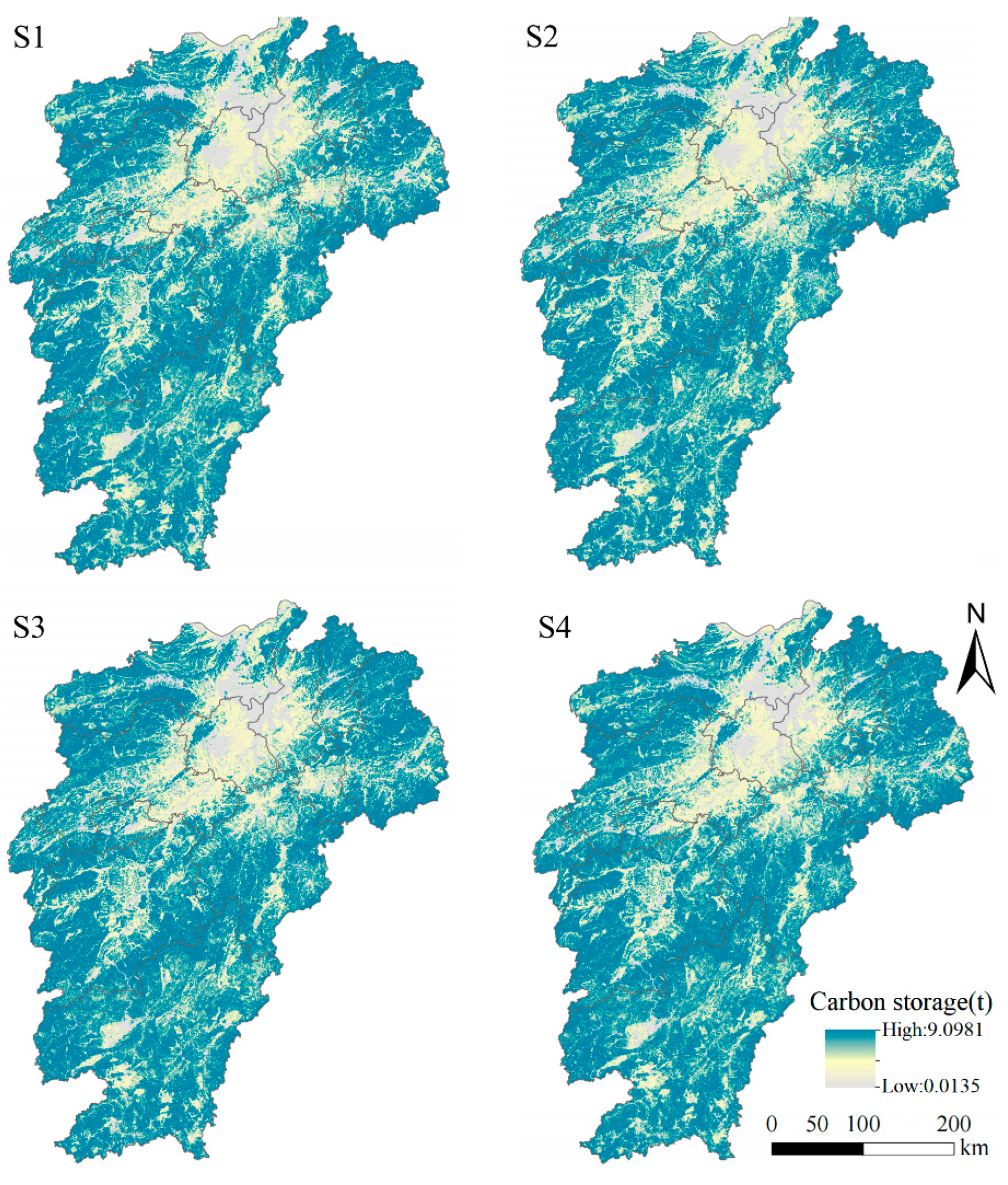
| Data Name | Data Accuracy | Data Source |
|---|---|---|
| DEM | 30 m | Data Center for Resource and Environmental Sciences, Chinese Academy of Sciences (https://www.resdc.cn/, accessed on 9 April 2023) |
| Slope | Obtained by DEM extraction | |
| Average annual temperature | 1 km | Data Center for Resource and Environmental Sciences, Chinese Academy of Sciences (https://www.resdc.cn/, accessed on 9 April 2023) |
| Average annual precipitation | ||
| GDP | ||
| Population | ||
| Distance to urban primary roads | Open Street Map (https://www.openstreetmap.org/, accessed on 9 April 2023) | |
| Distance to urban secondary roads | ||
| Distance to urban tertiary roads | ||
| Distance to highway | ||
| Distance to railroad | ||
| Distance to water system |
| Land Use Type | Cabove | Cbelow | Csoil | Cdead |
|---|---|---|---|---|
| Cropland | 3.55 | 2.09 | 32.34 | 0.54 |
| Forest | 46.9 | 11.2 | 42.3 | 0.69 |
| Grassland | 1.02 | 8.45 | 52.52 | 0.43 |
| Waters | 0.08 | 0.07 | 0.00 | 0.00 |
| Built-up land | 1.49 | 0.35 | 0.04 | 0.00 |
| Unused land | 0.36 | 0.53 | 1.81 | 0.03 |
| Land Use Type | Cropland | Forest | Grassland | Waters | Built-Up Land | Unused Land | Total Transfers Out | Rate-Out |
|---|---|---|---|---|---|---|---|---|
| Cropland | 37,583.00 | 4556.03 | 1084.55 | 973.22 | 2483.73 | 13.20 | 9110.72 | 34.56 |
| Forest | 4168.60 | 88,791.57 | 3924.93 | 739.59 | 775.82 | 41.94 | 9650.89 | 36.61 |
| Grassland | 1604.67 | 3556.12 | 6011.68 | 392.77 | 618.96 | 18.98 | 6191.51 | 23.49 |
| Waters | 373.01 | 167.46 | 61.38 | 5909.28 | 78.10 | 20.46 | 700.41 | 2.66 |
| Built-up land | 381.14 | 52.02 | 28.20 | 32.26 | 2318.91 | 0.55 | 494.16 | 1.87 |
| Unused land | 25.71 | 35.33 | 28.20 | 112.94 | 9.65 | 67.48 | 211.83 | 0.80 |
| Total transfers in | 6553.13 | 8366.96 | 5127.26 | 2250.78 | 3966.27 | 95.13 | 26,359.52 | - |
| Rate-in | 24.86 | 31.74 | 19.45 | 8.54 | 15.05 | 0.36 | - | 100 |
| Year/Period | Scenario | Cropland | Forest | Grassland | Waters | Built-Up Land | Unused Land |
|---|---|---|---|---|---|---|---|
| 2040 | S1 | 42,430.44 | 95,529.51 | 10,541.47 | 9441.57 | 8961.49 | 136.95 |
| S2 | 46,736.28 | 93,376.27 | 10,028.90 | 8981.61 | 7787.65 | 130.72 | |
| S3 | 43,022.25 | 98,501.49 | 9807.25 | 9202.82 | 6370.76 | 136.86 | |
| S4 | 44,343.39 | 98,661.65 | 8943.58 | 8932.57 | 6029.84 | 130.41 | |
| 2020–2040 | S1 | −1705.69 | −1629.02 | −597.47 | 1281.50 | 2676.31 | −25.65 |
| S2 | 2600.15 | −3782.26 | −1110.04 | 821.54 | 1502.47 | −31.88 | |
| S3 | −1113.88 | 1342.96 | −1331.69 | 1042.75 | 85.58 | −25.74 | |
| S4 | 207.26 | 1503.12 | −2195.36 | 772.50 | −255.34 | −32.19 |
| Year | Scenario | Cropland | Forest | Grassland | Waters | Built-Up Land | Unused Land | Total Carbon Storage |
|---|---|---|---|---|---|---|---|---|
| 2040 | S1 | 16,344.21 | 96,570.79 | 6579.99 | 14.16 | 168.48 | 3.74 | 119,681.36 |
| S2 | 18,002.82 | 94,394.08 | 6260.04 | 13.47 | 146.41 | 3.57 | 118,820.39 | |
| S3 | 16,572.17 | 99,575.16 | 6121.69 | 13.8 | 119.77 | 3.74 | 122,406.33 | |
| S4 | 17,081.07 | 99,737.06 | 5582.58 | 13.4 | 113.36 | 3.56 | 122,531.04 | |
| 2020–2040 | S1 | −657.03 | −1646.77 | −372.94 | 1.92 | 50.32 | −0.70 | −2625.21 |
| S2 | 1001.58 | −3823.48 | −692.89 | 1.23 | 28.25 | −0.87 | −3486.18 | |
| S3 | −429.07 | 1357.60 | −831.24 | 1.56 | 1.61 | −0.70 | 99.76 | |
| S4 | 79.83 | 1519.50 | −1370.35 | 1.16 | −4.80 | −0.88 | 224.47 |
Disclaimer/Publisher’s Note: The statements, opinions and data contained in all publications are solely those of the individual author(s) and contributor(s) and not of MDPI and/or the editor(s). MDPI and/or the editor(s) disclaim responsibility for any injury to people or property resulting from any ideas, methods, instructions or products referred to in the content. |
© 2023 by the authors. Licensee MDPI, Basel, Switzerland. This article is an open access article distributed under the terms and conditions of the Creative Commons Attribution (CC BY) license (https://creativecommons.org/licenses/by/4.0/).
Share and Cite
Huang, Y.; Xie, F.; Song, Z.; Zhu, S. Evolution and Multi-Scenario Prediction of Land Use and Carbon Storage in Jiangxi Province. Forests 2023, 14, 1933. https://doi.org/10.3390/f14101933
Huang Y, Xie F, Song Z, Zhu S. Evolution and Multi-Scenario Prediction of Land Use and Carbon Storage in Jiangxi Province. Forests. 2023; 14(10):1933. https://doi.org/10.3390/f14101933
Chicago/Turabian StyleHuang, Yue, Fangting Xie, Zhenjiang Song, and Shubin Zhu. 2023. "Evolution and Multi-Scenario Prediction of Land Use and Carbon Storage in Jiangxi Province" Forests 14, no. 10: 1933. https://doi.org/10.3390/f14101933
APA StyleHuang, Y., Xie, F., Song, Z., & Zhu, S. (2023). Evolution and Multi-Scenario Prediction of Land Use and Carbon Storage in Jiangxi Province. Forests, 14(10), 1933. https://doi.org/10.3390/f14101933








